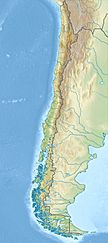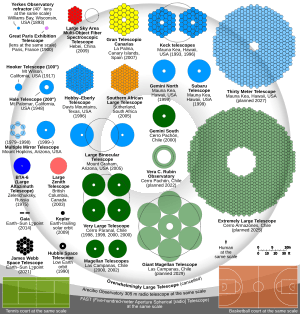Magellan Telescopes facts for kids
 |
|
| Named after | Walter Baade, Landon T. Clay |
|---|---|
| Part of | Las Campanas Observatory |
| Location(s) | Atacama Region, Chile |
| Coordinates | 29°00′54″S 70°41′30″W / 29.015°S 70.6917°W |
| Organization | Carnegie Institution for Science |
| Altitude | 2,516 m (8,255 ft) |
| First light | 15 September 2001, 7 September 2002 |
| Telescope style | Gregorian telescope optical telescope |
| Number of telescopes | 2 |
| Diameter | 6.5 m (21 ft 4 in) |
The Magellan Telescopes are two powerful optical telescopes in Chile. They are located at the Las Campanas Observatory. Each telescope has a main mirror about 6.5 meters (21 feet) wide.
They are named after famous people: astronomer Walter Baade and philanthropist (someone who gives money to good causes) Landon T. Clay. The Baade telescope started working on September 15, 2000. The Clay telescope began on September 7, 2002. Many universities and science groups helped build and now run these telescopes. These include the Carnegie Institution for Science, University of Arizona, Harvard University, the University of Michigan, and the Massachusetts Institute of Technology.
The telescopes were also named after the famous explorer from the 1500s, Ferdinand Magellan.
Contents
What Are the Magellan Telescopes?
The Magellan Telescopes are a pair of very large optical telescopes. This means they collect visible light from space. They are located high up in the mountains of Chile, which is a great place for stargazing. The clear skies and high altitude help them get amazing views of the universe.
These telescopes are crucial for many astronomy projects. They help scientists study distant galaxies, stars, and even search for new planets.
The Giant Magellan Telescope
The Giant Magellan Telescope (GMT) is an even bigger telescope being built. It will be one of the largest telescopes ever made. It is part of a program to build extremely large telescopes in the United States.
Tools on the Magellan Telescopes
Each Magellan telescope has special tools, called instruments. These tools help astronomers study light from space in different ways. They can take pictures, split light into colors (like a prism), and measure how bright things are.
Baade Telescope Instruments
The Baade telescope uses several instruments:
- Inamori Magellan Areal Camera and Spectrograph (IMACS)
- FourStar
- Folded port InfraRed Echellette (FIRE)
- Magellan Echellete (MagE)
Clay Telescope Instruments
The Clay telescope also has its own set of tools:
- Magellan Inamori Kyocera Echelle (MIKE) spectrograph
- Low-Dispersion Survey Spectrograph-3 (LDSS-3)
- Megacam imager
- MagAO
- Michigan/Magellan Fiber System (M2FS)
Searching for Planets
The Magellan Telescopes are used in a special project called the Magellan Planet Search Program. This program uses the MIKE spectrograph on the Clay telescope. Scientists use it to look for planets orbiting other stars. They do this by carefully watching how stars wobble. A wobble can mean a planet's gravity is pulling on the star.
MagAO Adaptive Optics System
In 2013, the Clay telescope got a special upgrade called MagAO. This is an adaptive optics system. Think of it like super-powered glasses for the telescope! It helps correct blurry images caused by Earth's atmosphere.
MagAO makes images incredibly sharp. It can see details as small as a dime from 100 miles away! This means astronomers can see very tiny objects in space much more clearly.
The MagAO mirror was originally meant for another telescope, the Large Binocular Telescope. But it got damaged. Scientists were able to fix it and make it work for the Magellan II (Clay) telescope. They had to cut the mirror a bit smaller to remove the broken edge.
Images for kids
See also
 In Spanish: Telescopios Magallanes para niños
In Spanish: Telescopios Magallanes para niños
- List of largest optical reflecting telescopes
- Giant Magellan Telescope





